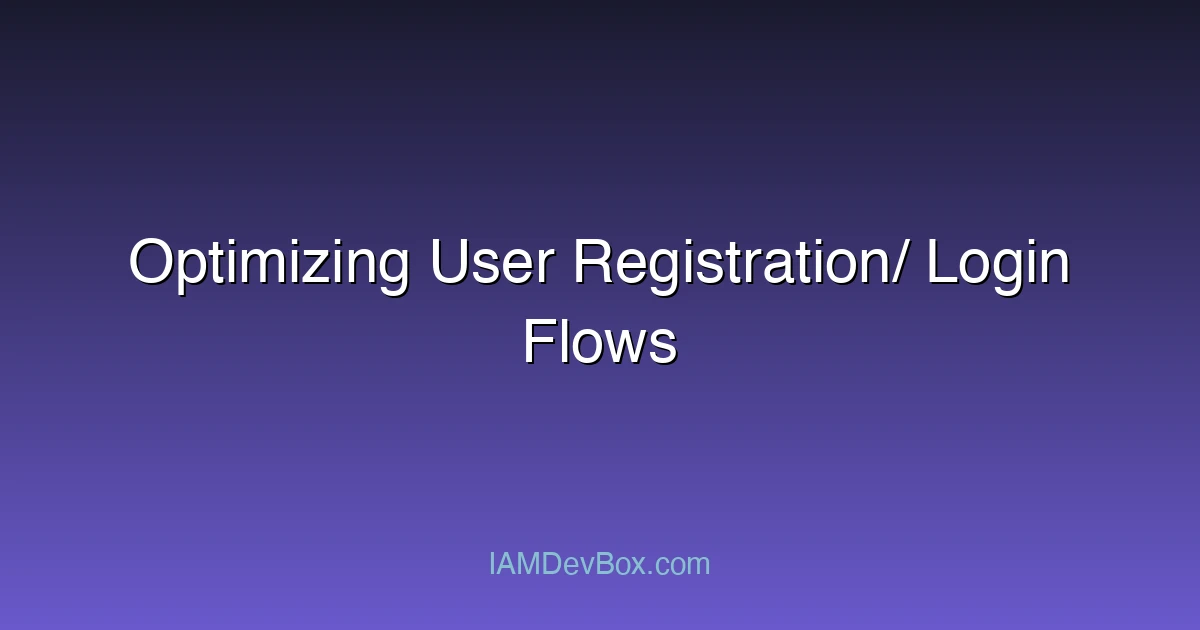Visual Overview:
graph TB
subgraph "Authentication Methods"
Auth[Authentication] --> Password[Password]
Auth --> MFA[Multi-Factor]
Auth --> Passwordless[Passwordless]
MFA --> TOTP[TOTP]
MFA --> SMS[SMS OTP]
MFA --> Push[Push Notification]
Passwordless --> FIDO2[FIDO2/WebAuthn]
Passwordless --> Biometric[Biometrics]
Passwordless --> Magic[Magic Link]
end
style Auth fill:#667eea,color:#fff
style MFA fill:#764ba2,color:#fff
style Passwordless fill:#4caf50,color:#fff
OAuth 2.0 is a widely used authorization framework that enables applications to securely grant access to resources. While it’s crucial for user data and ensuring seamless interactions, the user registration and login flows can be a significant pain point for many applications. In this blog post, we’ll explore the importance of optimizing user registration and login flows, discuss common challenges, and provide practical tips for improving the overall user experience.
Why Optimize User Registration/ Login Flows?
User registration and login flows are critical components of any application, as they determine the first impression users have of your product. A well-designed flow can lead to increased user adoption, reduced bounce rates, and improved overall user satisfaction. On the other hand, a poorly designed flow can result in frustration, decreased engagement, and ultimately, a loss of customers.
The primary goal of user registration and login flows is to authenticate users and grant them access to the application’s resources. However, this process can be complex, especially when dealing with multiple authentication providers, password reset mechanisms, and security requirements. To optimize these flows, it’s essential to focus on the user experience, ensuring that the process is efficient, secure, and easy to understand.
Common Challenges in User Registration/ Login Flows
-
User Experience: A lengthy or complicated registration process can lead to user frustration, resulting in abandoned sign-ups and decreased conversions.
-
Security: Ensuring the security of user data and preventing unauthorized access to resources is crucial. This can be challenging, especially when dealing with multiple authentication providers and password reset mechanisms.
-
Scalability: As the number of users increases, the registration and login flows must be able to handle the load efficiently, avoiding performance issues and downtime.
-
Integration: Integrating multiple authentication providers, such as social media platforms and SSO solutions, can be complex and require careful configuration.
Best Practices for Optimizing User Registration/ Login Flows
- Simplify the Registration Process: Minimize the number of fields required for registration and use auto-fill functionality to reduce the amount of user input.
- Implement Password Reset Mechanisms: Provide users with a convenient way to reset their passwords, reducing the risk of forgotten passwords and the need for support requests.
- Use Multi-Factor Authentication (MFA): Implement MFA to add an extra layer of security, reducing the risk of unauthorized access to resources.
- Integrate Multiple Authentication Providers: Integrate multiple authentication providers to offer users a choice of login options, improving the overall user experience.
- Monitor and Analyze User Behavior: Monitor user behavior and analyze data to identify areas for improvement, optimizing the registration and login flows accordingly.
Real-World Examples
- Amazon: Amazon’s registration process is simple and efficient, requiring only basic user information and a password. The company also offers a convenient password reset mechanism, making it easy for users to regain access to their accounts.
- Google: Google’s registration process is seamless, allowing users to sign up using their existing Google accounts. The company also offers a robust password reset mechanism, making it easy for users to recover their accounts.
Conclusion
Optimizing user registration and login flows is crucial for ensuring a positive user experience, improving security, and increasing conversions. By simplifying the registration process, implementing password reset mechanisms, using multi-factor authentication, integrating multiple authentication providers, and monitoring user behavior, you can improve the overall user experience and reduce the risk of unauthorized access to resources. Remember, a well-designed user registration and login flow is key for building trust with your users and ensuring the long-term success of your application.
Mermaid Flowchart
This flowchart illustrates the user registration and login flow, from registration to authentication and authorization. By simplifying and optimizing this flow, you can improve the user experience and reduce the risk of unauthorized access to resources.
